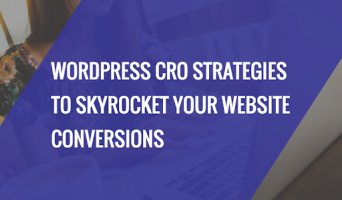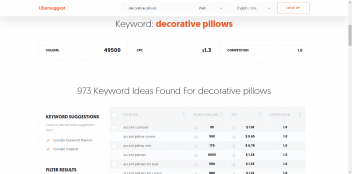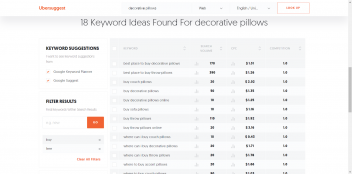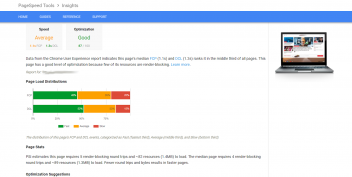Without generating sales, your business is bound to kick the bucket. It doesn’t matter if you have millions of online traffic; if none of them will purchase or subscribe to any of your services, then you’ll never be profitable. To help you with converting your web visitors into paying customers — allow me to share


Without generating sales, your business is bound to kick the bucket.
It doesn’t matter if you have millions of online traffic; if none of them will purchase or subscribe to any of your services, then you’ll never be profitable.
To help you with converting your web visitors into paying customers — allow me to share with you these conversion optimization strategies for your website.
If you’re sick and tired of seeing your sites generating very little to no sales at all, then you need to follow these tips.
Let’s hop right in.
1. Focus on Long-Tail Keywords
When it comes to conversion optimization, keywords matter. You’re probably thinking — “But that involves SEO!”
Listen. SEO and CRO go hand in hand. They’re Bonnie and Clyde, they’re Thelma and Louise, they’re Jordan and Pippen… well, you get the idea.
Again, CRO and SEO are undeniably linked together. Integrate them seamlessly into your marketing campaigns and conversions will start pouring in sooner or later.
As a WordPress user, chances are you’ve read several articles on the internet about the effective ways to do SEO for WP blogs. If that’s the case, then you should already know by now why keywords matter.
Now here’s one indispensable rule in doing keyword research: focus on targeting long-tail keywords.
Unlike broad keywords, long-tail ones are comprised of three or more words. By virtue of their length, long-tail keywords are more specific and therefore have lower competition, hence better chances of conversions.
To come up with relevant long-tail keywords that could drive traffic to your website, you can use keyword research tools like Ubersuggest and AdWords Keyword Planner, among many others.
For our example, let’s go to the Ubersuggest site. After entering your broad keywords in the empty field and specifying the location, the tool will generate hundreds of keyword suggestions for you in seconds.


In coming up with a final list of seed keywords, make sure that you take into account the search volume and the competition level.
2. Target keywords with high commercial intent
After coming up with new keyword ideas, you have to target phrases with high commercial intent.
Intent, as applied to keywords, comes in three different types:
- Navigational. The immediate intent of these keywords is to reach a particular site for navigational purposes.
- Informational. The intent of the search is to acquire information assumed to be on the internet in a static form.
- Transactional. This type of search involves queries where the user is looking to buy or download something or sign up for a service.
Since your main target for driving organic traffic to your site is to sell or acquire leads, you need to focus on targeting transactional keywords (phrases that contain commercial terms such as “buy,” “discount,” “hire,” “free,” and so on). These are keywords with high commercial intent, meaning they are the words likely to be used by users who are looking to buy something.
If you’re stumped for ideas, you can use keyword research tools again to generate transactional keywords which you can target for your marketing campaigns.
Let’s use Ubersuggest again for our “decorative pillows” example. Enter commercial keywords like “buy” or “discount” under “Filter Results” and the keyword research tool will churn out a list of transactional keywords for you in seconds.


3. Use fonts that convert
The fonts or typefaces used in presenting written content impacts conversions so much more than most people realize.
If you don’t believe that, then read the short statement below and see if you’ll be able to take it seriously:
On average, 80 percent of babies are born with some sort of birthmark.
Cyrus Highsmith, a legendary typeface designer, says it best:
“Typography is the detail and the presentation of a story. It represents the voice of an atmosphere, or historical setting of some kind. It can do a lot of things.”
See what we did there?
Put another way, the font you use in your web content can significantly impact the mood of the reader. With the right font, your content can bolster your credibility as a brand, and bring about the emotional response that can result in conversions.
There’s no one-size-fits-all approach in typography. The font you should use will depend on your site, your niche, your target audience, and many other considerations.
If you’re not sure which fonts to use in your WordPress content, the infographic below should serve as a comprehensive guide.


[Source: The Daily Egg]
4. Increase your WordPress site’s loading speed
Your website’s loading speed directly impacts the user experience. According to stats released by Kissmetrics, the average site visitor is likely to abandon a website that takes more than 3 seconds to load. A high bounce rate can’t be good for your overall SEO strategy.
There are many ways to speed up your WordPress site’s loading speed. In this section, we’ll be going over some of them.
But before proceeding, you need to test your website’s speed first. There are a ton of websites that can do this for you, such as Google PageSpeed Insights, Pingdom Website Speed Test, GTmetrix, and many others.
Google PageSpeed Insights is a good option. For one, it provides you with comprehensive page stats as well as specific suggestions on how to optimize your WordPress site.


5. Choose a reliable hosting provider
Picking a hosting provider to host your WordPress site is one aspect of website management you can’t afford to scrimp on. Hosting providers provide you with the server that will store your website’s information, after all.
There are many reliable hosting providers to choose from, such as Fly Wheel, Go Daddy, WP Engine, and HostGator.
One may be better than the other based on your personal preferences, but you’d do well to give each one a look and check which one will suit your business needs better.
Also, don’t use a shared hosting plan. Sure, you can settle for a shared plan if your budget is limited but make sure that you upgrade soon as your site requires more bandwidth.
6. Choose a good WordPress theme
The WordPress theme you use is integral to the overall look and functionality of your site. But as a business owner, it’s important that you strive for simplicity.
Flashy animations, large fancy images, and complex layouts may be neat to look at, but it’s always better to do away with them if they’re distracting your users from the information that will prompt them to buy what you have to offer.
So what makes a good, reliable WordPress theme? As a general rule of thumb, you should choose one that is SEO-optimized, has a simple yet good-looking design, supports all popular plugins, and can generate proper HTML5 (for the latter, you can check using W3C’s Markup Validation service).
7. Optimize images
The importance of optimizing your site’s images can’t be emphasized enough. Here are the main benefits of image optimization:
- Your site will load faster
- Bounce rate will be smaller
- Your site’s Google PageSpeed score will improve.
- The servers housing your website will require fewer resources, thus saving you money
In short, optimizing your images eliminates the chances of visitors leaving your site due to slow load times. This, of course, will prove beneficial in boosting your website conversions.
Granted, optimizing images for your WordPress site can be an arduous, complicated process. But you can cut to the chase by using an image optimization plugin. WP Smush, for example, comes with a “Bulk Smush” feature, which allows you to optimize all images from your media library in one go.
Final Word
Let’s face it: You can’t turn your web visitors into paying customers if your site doesn’t have the bells and whistles to influence them to purchase.
While the tips above are “deadly” enough to increase your conversion rate, I’d like to highlight that these are just some of the many tactics you can use to improve your conversions.
There are several other SEO strategies that you can use to get better results out of your marketing campaigns.
Are you struggling with your site’s conversion rate? If you answered with a “yes,” then please add them in the comments section below.

